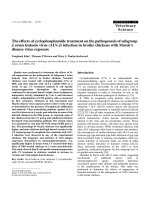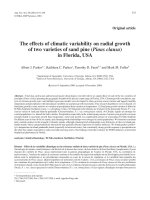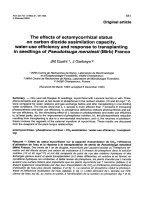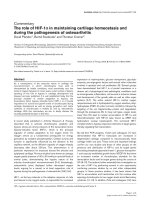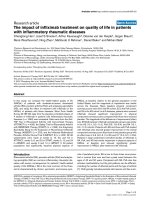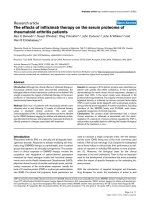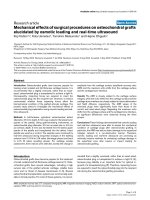Báo cáo y học: " The effects of IQPLUS Focus on cognitive function, mood and endocrine response before and following acute exercise" pps
Bạn đang xem bản rút gọn của tài liệu. Xem và tải ngay bản đầy đủ của tài liệu tại đây (315.25 KB, 6 trang )
RESEARCH ARTICLE Open Access
The effects of IQPLUS Focus on cognitive
function, mood and endocrine response before
and following acute exercise
Adam G Parker
1*
, Josh Gordon
2
, Aaron Thornton
2
, Allyn Byars
1
, John Lubker
4
, Michelle Bartlett
2
, Mike Byrd
3
,
Jonathan Oliver
3
, Sunday Simbo
3
, Chris Rasmussen
3
, Mike Greenwood
3
and Richard B Kreider
3
Abstract
Background: Phosphatidylserine (PS) is a phospholipid found in cell membranes of most animals and plants. PS
has been shown to reduce stress and increase performance in runner s, cyclists and golfers. The purpose of this
study was to investigate the effects of a PS containing formulation on cognitive function , mood and endocrine
response before and after intense resistance exercise.
Methods: 18 lower body, resistance trained, college aged males ingested 14 days of supplement (IQPLUS Focus,
providing 400 mg of soy-derived PS) and a Placebo (PL), in a randomized, double-blind, placebo controlled, cross-
over manner. Following 14 days of supplementation, participants performed an acute bout of lower body
resistance training. Mood (Profile of Mood States, POMS) and cognitive function (Serial Subtraction Test, SST) were
measured prior to, 5 minutes after, and 60 minutes after exercise. Venous blood samples were collected prior to,
and 5, 15, 25, 40 and 60 minutes after exercise. Blood samples were analyzed for plasma cortisol and testosterone.
Data were analyzed using repeated measures ANOVA .
Results: PS supplementation significantly reduced the time nee ded for a correct calculation on the SST by 20%
(reduced by 1.27 s per calculation; PL: 6.4 s, PS: 5.13 s; p = 0.001), and reduced the total amount of errors by 39%
(PL: 1.28 + .69, PS: .78 + .27, p = 0.53), and increased the amount of correct calculations by 13% (PL: 22.1 + 2.24,
PS: 24.9 + 1.52, p = 0.07 ) prior to or in response to exercise compared to PL. Following exercise, there was no
difference in SST scores between PS and PL. There were no significant changes in regards to mood or endocrine
response to exercise as a result of PS supplementation.
Conclusion: PS supplementation significantly increased cognitive function prior to exercise. Improved cognitive
function could benefit athletes and non-athletes alike. PS did not appear to affect mood or endocrine response
prior to or following resistance exercise.
Keywords: supplement, exercise, endocrine response, cognitive function, mood
Background
It has been well documented that nutrients found in
common food sources serve important functions in the
human body. Many of these nutrients, l ike the essential
vitamins and minerals we need every day, are required
for survival. Other nutrients have not been deemed
essential, however supplementation has been shown to
be beneficial. One such nutrient is phosphatidylserine
(PS). PS is a phospholipid found in cell membranes of
most animals and plants [1]. In humans, PS is located in
the internal layer of cell membranes where it serves
many functions including regulation of receptors,
enzymes, ion channels, and signaling molecules [1]. It is
via these functions that PS may alter endocrine and cog-
nitive function. Westerners ingest PS regularly in their
diets in the amount of approximately 130 mg/day [1].
However, higher intake levels of PS through supplemen-
tation has been shown to be more beneficial than what
* Correspondence:
1
Department of Kinesiology, Angelo State University, San Angelo, TX, 76909,
USA
Full list of author information is available at the end of the article
Parker et al. Journal of the International Society of Sports Nutrition 2011, 8:16
/>© 2011 Parker et al; licensee BioMed Central Ltd. This is an Open Access artic le distributed under the terms of the Creative Commons
Attribution License ( which permits unrestricted use, distribution, and reproduction in
any medium, provided the original work is properly cited.
is normally ingested from diet alone, improving age-
related cognitive decline [2]. PS supplements have his-
torically been derived from bovine brain tissue w here it
is particularly high in concentration, but due to health
concerns related to the transfer of bovine spongiform
encephalopath y (BSE), PS supplements for human con-
sumption are now produced from soy phospholipids.
There have been several studies that suggest supplemen-
tation with anywhere from 200-800 mg of PS per day
can result in improved mood, cognitive functioning,
sport performance, endocrine response to stress, and
decreased soreness following exercise [ 1,3]. Short-term
(10 days) high-dose (600 mg per day) supplementation
with PS has been shown to attenuate cortisol response
to moderate exercise via activiation of th e hypothalamo-
pituitary-adrenal axis [4] and low-dose (200 mg per day)
long-term (6 weeks) consumption of PS and carbohy-
drates resulted in a reduction of perceived stress and
improved golf performance [ 5]. Additionally, supple-
mentation of 200 mg per day has been shown to induce
a state of relaxation before and after exposure to a
stressful environment [6]. By supplementing with PS,
individuals may potentially be able to obtain better
results from any exercise they participate in while at the
same time improve mood and mental functioning. The
purpose of this study was to determine if supplementa-
tion with PS (providing 400 mg of soy-derived PS) and a
Placebo (PL) for 14 days, would i mprove cognitive per-
formance, mood and/or endocrine response prior to
and/or following a stress inducing bout of lower body,
resistance exercise.
Methods
Experimental Approach to the Problem
Eighteen, physi cally active, college-aged males (N = 18,
22.5 ± 2.2 years of age, 1.77 ± .06 m, 84.4 ± 13.6 kg)
ingested two servings of PS (IQPLUS Foods LLC, Mil-
waukee, WI, a proprietary formulation containing PS
enriched soybean derived phospholipi ds, containing 200
mg of PS per serving) and a matching placebo (rice
flour) for 14 days each (28 days t otal) in a random, pla-
cebo-controlled, double blind, cross-over design, with
no washout period between supplements. Participants
were deemed physically active if they had participated in
lower body resistance exercise at least once per week for
the prior 3 months. Participants were excluded from this
investigation if they had any medical conditions that
required prescription medication or prevented them
from completing the exercise sessions. Participants were
also not allowed to participate if they had consumed
any nut ritional supplement (except for a multivitamin/
mineral) within the previous 30 days. All participants
were informed of the requirements of the study and
signed an informed consent form in compliance with
the Guidelines for Research on Human Subjects of West
Texas A&M U niversity. Participant demographics are
presented in table 1.
Familiarization
Participants in this study were asked to arrive at the
Human Performance Research Laboratory (HPRL) at
West Texas A&M University having fasted overnight.
Participants underwent a fasting venous blood draw col-
lected from the antecubital fossa, to determine pre-sup-
plementation plasma cortisol and t estosterone levels.
Additionally, participants were required to perform 1
repetition maximum (RM) lifts in the Smith machine
squat ( SQ), leg press (LP), and leg extension (LE) exer-
cises after performing a standardized w arm up of walk-
ing briskly on a treadmill for f ive minutes. 1RM testing
followed the National Strength and Conditioning Asso-
ciations guidelines. Participants also performed a Se rial
Subtraction Test an d a Profile of Mood States question-
naire to familiarize themselves with these instruments.
Supplementation Protocol
Following familiarization, participants were randomly
assigned to consume P S or PL for 14 days each. Follow-
ing 14 days of supplementation with their first assigned
supplement, participants reported to the HPRL for their
first testing session. Upon completion of the first testing
session, participants were given a 14 day supply of either
PS or PL, depending on which supplement they took for
the previous 14 days. No washout period was followed
after the first supplementation period. After completing
the 14 day supplementation period with the other sup-
plement, participants reported to the HPRL for their
second and final testing session.
Cognitive Function and Mood Measurement
In order to analyze cognitive function, a Serial Subtrac-
tion Test (SST) was used. This consisted of a two min-
ute timed test in which the participants subtracted the
number 7 from a random 4 digit number in order to
measure how quickly and accurately they can compute a
simple mathematical problem. The average time per
Table 1 This table shows demographic and strength data
of the study participants
Participant Demographics and Strength Measures
Age 22.5 ± 2.2
Height (m) 1.77 ± .06
Weight (kg) 84.4 ± 13.6
Squat 1RM (kg) 125.2 ± 33.9
Leg Press 1RM (kg) 254.9 ± 80.2
Leg Extension 1RM (kg) 112.0 ± 26.9
Values are expressed as mean ± standard deviation.
Parker et al. Journal of the International Society of Sports Nutrition 2011, 8:16
/>Page 2 of 6
correct calcula tion, number of correct calculations, and
number of mistakes were recorded. If an incorrect cal-
culation was made, subsequent calculations were
deemed correct based on the new starting number [ 7].
Analysis of mood was performed by administering the
Profile of Mood States (POMS) questionnaire. The
POMS measurement i s used to measure transient mood
states and measures six factors i ncluding: tension,
depression, anger, fatigue, vigor, and confusion. The
POMS has been used extensively in the past to examine
changes in mood states as a result exercise [8].
Testing Sessions
On both the first and second testing sessions, partici-
pants reported to the HPRL in a fasted state. In an
attempt to account for diurnal variations in plasma cor-
tisol levels, all testing sessions for each individual sub-
jectwerescheduledforthesametimeofday,although
that time varied between participants. Participants’ heart
rate and blood pressure were recorded, a pre-exercise
(PRE) venous blood sample was collected, and a pre-
exercise SST and POMS were collected. Following preli-
minary procedures, participants performed a 5 minute,
whole body warm-up by walking briskly on a treadmill.
Participants then performed 5 sets of 10 repetitions at
70% of their pre-determined 1RM for SQ, LP, and LE.
Participants were allowed a 90 second rest between sets
and a 180 second rest between exercises. This exercise
protocol was determined to result in increases in plasma
cortisol of approximately 87% in pilot testing. After
completing the acute exercise bout, participants per-
formed an SST and POMS at 5 and 60 minutes post-
exercise (5POST and 60POST), and had venous blood
samples collected at 5, 15, 25, 40, and 60 minutes post-
exercise (5POST, 15POST, 25POST, 40POST, and 60
POST).
Blood Analysis
All blood samples were collected via repeated venous
blood draws from the antecubital fossa. Blood samples
were centrifuged at 3, 400 rpm for 15 minutes, with the
serum stored at -20°C for later analyses, as indicated in
the instruction manual provided with the Enzyme
Immunoassay (EIA) kits. Serum samples were then
assayed for total testosterone and cortisol (Diagnostic
System Laboratories, Webster, TX) viaEIA using an
ELx808 microplate reader (BioTek Intruments, Inc.,
Winooski, VT) in t he Exercise and Sport Nutrition
Laboratory at Texas A&M University. All serum samples
and reagents were brought to room temperature prior to
analysis. 50 μL of each standard, control, and participant
sample were added to their respective wells in addition
to all required reagents. After the necessary incubation
period, the absorbance of the solution in the wells was
measured at 450 nm. A standard curve for concentra-
tion of serum cortisol and testoster one was developed
via the data reduction software included with the micro-
plate reader. Subject samples were compared to the
standard c urve to determine concentrations of cortisol
and testosterone present.
Statistical Analyses
SST data were analyzed using a 2 × 3 (treatment × time)
repeated measures (RM) analysis of variance (ANOVA).
POMS data were analyzed using a 2 × 3 (treatment ×
time) RM multiple analysis of variance (MANOVA).
Serum cortisol and total testosterone data were analyzed
using separate 2 × 6 (treatment × time) repeated mea-
sures ANOVAs. Bonferonni post-hoc procedures were
used to compare means for any signif icant main effects
or interactions. Additionally, paired samples t-tests were
performed to compare SST results collected at PRE.
Mauchly’s test of sphericity was performed on all depen-
dent variables with the Huynh-Feldt correction factor
being utilized for any dependent variable that did not
meet the assumption of sphericity. All statistical analyses
were performed using SPSS 15.0 software for Windows
(SPSS, Inc., Chicago, IL) w ith a probab ility level of p <
0.05 throughout.
Results
Cognitive Function
SST data are presented in Figure 1. PS suppl ementation
increased speed of calculation by 20% (PL: 6.44 ± 2.5 s,
PS: 5.14 ± 1.3 s, p = 0.001), decreased the amount o f
mistakes made by 39% (PL: 1.28 ± .69, PS: .78 ± .27, p =
0.53), and increased the amount of correct calculations
by 13% (PL: 22.1 ± 2.24, PS: 24.9 ± 1.52, p = 0.07) pre
exercise. Statisti cal analysis revealed no significant treat-
ment group differences (p > 0.05), however, there was a
significant time × group interaction (p = 0.04), and a
significant main effect for time (p = 0.045). Further sta-
tistical analysis revealed a significant reduction in time
per correct calculation between supplement groups on
the SST of approximat ely 20% (PL: 6.44 ± 2.5 s, PS: 5.14
± 1.3 s, p = 0.007), and a significant decrease in time
per correct calculation across both s upplement groups
between PRE and 60POST (5.1 ± 1.7 sec, p = 0.02).
Mood
POMS data are presented in Figure 2. There were no
significant differences between treatment groups or
treatment × time interactions for any of the components
of the POMS questionnaire (p > 0 .05). The overall RM
MANOVA for the POMS data resulted in a significant
main effect for time. POMS results indicated a signifi-
cant decrease in vigor from PRE to 5POST (p = 0.005)
and 60POST (p = 0.000), as well as a significant increase
Parker et al. Journal of the International Society of Sports Nutrition 2011, 8:16
/>Page 3 of 6
in fatigue from PRE to 5POST (p = 0.014). Also, a sig-
nificant increase for tension from PRE to 5POST (p =
0.049) with a significant decrease from PRE to 60POST
(p = .000) and 5POST to 60POST (p = 0.031). Finally,
total mood disturbance was significantly different
between all three time points (p = 0.000).
Endocrine Response
Endocrine data are presented in table 2. There were no
significant differences between treatment groups or
treatment × time interactions for serum cortisol, total
testosterone, or the testosterone to cortisol ratio (p >
0.05). There was, however, a significant main effect for
Figure 2 This fi gure shows the mean POMS scores from both supplement groups combined to illustrate the effe ct exercise ha d on
mood data. There were no significant differences between supplement groups for POMS data (p > 0.05).
Figure 1 Calculation speed. Data are presented as seconds per correct calculation on the SST. * The PS group scored significantly lower at PRE
compared to the PL group but not after exercise (p = 0.007).
Parker et al. Journal of the International Society of Sports Nutrition 2011, 8:16
/>Page 4 of 6
time for cortisol (p = 0.000) and testosterone (p =
0.004), indicating that exercise significantly increased
both cortisol and testosterone levels across both treat-
ment groups. Cortisol levels across time for both sup-
plement groups were significantly higher at 5POST,
15POST, and 25POST compared to PRE (p = 0.001, p =
0.008, and p = 0.037 respectively), significantly lower at
40POST compared to 5POST, 15POST, and 25POST ( p
= 0.0 01, p = 0.001, and p = 0.003 respectively, and s ig-
nificantly lower at 60POST compared to 5POST,
15POST, 25POST, and 40POST (p = 0.000, p = 0.000, p
= 0.000, and p = 0.008 respectively). Testosterone levels
across time for both supplement groups were signifi-
cantly higher at 5POST and 15POST compared to PRE
(p = 0.034 and p = 0.002 respectively), and signifi cantly
lower at 60POST compared to 5POST and 15POST (p
= 0.017 and p = 0.013 respectively).
Discussion
The resu lts of this study have shown that supplementa-
tion with PS daily for 14 days significantly improved
cognitive function prior to an acute bout of intense,
lower-body resistance training. Supplementation with PS
had no effect on mood, serum cortisol, or serum total
testosterone. There were also no negative side-effects
reported by any of the study participants in regards to
PS supplementation.
Previous research has shown evidence that cognitive
function may be improved by supplementing with PS.
Baumeister et al., concluded that 42 days of supplemen-
tation with 200 mg of PS resulted in changes in electro-
encephalogram (EEG) activity indicating a more relaxed
state following induced stress. This particular study also
examined cognitive function using the Stroop colour-
word interference te st and the D2 concentration te st.
Despite the fact that the participants in this study had
improved EEG readings, there was no evidence of signif-
icant differences in the measures of cognitive function
as observed in our study [6]. According to a review arti-
cle investigating the findings of PS supplementation in
humans, Jäger et al., reported that significant
improvements in cognitive function have been observed
in elderly populations, but not in younger populations
[1]. Additionally, an experimen t by Jäger and colleagues
found that golfers had improved golf performance fol-
lowing 42 days of supplementation with 200 mg of PS
and 15 g of carbohydrates [5]. This improvement in per-
formance may potentially be related to the relaxation
effect observed in the study by Baumeister. It is possible
that a relaxed mind may be able to better focus on
sports tasks that require a great deal of concentration
on sport skill performance, thus resulting in improved
performance. According t o our research, it seems that
the most beneficial effect of PS supplementation is
improvement in cognitive functi on prior to exercise that
could potentially translate into improved performance in
sports r equiring a relaxed state of mind. Further
research is warranted to examine the effects of P S sup-
plementation on sport performance.
Our findings did not show any significant changes in
mood states as measured by the POMS. An article by
Benton et al. reported that young adults who scored
high in measures of neuroticism experienced feeling less
stress and had a better mood after PS supplementation
of 300 mg/day for one month [9]. Another study investi-
gated the effects of three different doses of PS (400, 600,
or 800 mg/day for 21 days) on pit uitar y adrenal reactiv-
ity and the psychological response to a mental and emo-
tional stressor [10]. It was observed that the 400 mg/day
supplementation level resulted in an attenuated serum
adrenocorticotropic hormone and c ortisol, and salivary
cortisol response to the stressor, as well as a decrease in
distress. These effects were not seen in the other PS
supplementation groups (600 or 800 mg/day). The
results of our study showed that 14 days of supplemen-
tation with 400 mg of PS had no effect on serum corti-
sol or total testosterone levels. There have been
numerous articles published reporting that PS supple-
mentation can a ffect endocrine function, specifically by
blunting cortisol response to stress [3,10,11]. However,
several s tudies have also reported no changes in endo-
crine function as a result of PS suppleme ntation [12,13].
Table 2 This table shows serum levels of total testosterone (ng/mL) and cortisol (μg/dL).
Endocrine Response
PRE 5POST 15POST 25POST 40POST 60POST
CORTISOL
PL 17.2 ± 5.1 24.8 ± 9.4 25.4 ± 9.7 22.9 ± 9.5 19.7 ± 9.8 17.1 ± 8.2
PS 17.5 ± 7.1 28.8 ± 11.3 25.9 ± 11 24.2 ± 10.5 20.9 ± 10.7 19.5 ± 11.2
TESTOSTERONE
PL 8.3 ± 2.9 11.3 ± 5.7 10.6 ± 3.5 9.7 ± 3.2 9.0 ± 2.1 8.6 ± 2.2
PS 8.9 ± 2.0 10.9 ± 3.6 10.8 ± 2.3 9.9 ± 1.7 9.9 ± 2.9 8.7 ± 3.2
Values are expressed as means ± standard deviation. There were no significant differences between supplement groups for serum total testosterone or cortisol
(p > 0.05)
Parker et al. Journal of the International Society of Sports Nutrition 2011, 8:16
/>Page 5 of 6
Very few studies have been performed examining the
effects of PS supplementation on testosterone levels. In
one article, Starks found no significant changes in tes-
tosterone levels after 10 days of supplementation with
600 mg of PS [4] . These equivocal find ings on mood
and endocrine response have been attributed to differ-
ences in training status, dose and duration of supple-
mentation and the kind of physical and mental stress
[1,13]. Due to the strenuous nature of the exercise pro-
tocol used in this study, only resistance trained indivi-
duals were allowed to participate. The lack of significant
changes to endocrine response between supplement
groups may be due to the fact that the participants were
not placed under an adequate amount of physical stress
to elicit large enough changes in cortisol or testosterone
levels. Perhaps more research is warranted to examine
the effects of varying levels of both mental and physical
stress on trained and untrained individuals to identify
the populations tha t could benefit most from supple-
mentation with PS.
Conclusions
Supplementation with PS is an effective means of
improving cognitive function in young, healthy college
students. PS significantly increased the speed of calcula -
tions by 20%, reduced the total amount of errors by 39%
and increased the total amount of correct calculations
by 13%. Supplementation with PS did no t have any sig-
nificant effect on cortisol, total testosterone, or mood.
This study is the first to suggest that a soy-derived PS
formulation significantly increased mental performance
in young adults prior to exercise, contributing to the
growing body of evidence suggesting that soy-derived PS
benefits cognition. Further research may be directed at
determining the optimum dose of PS to achieve favor-
able endocrine response in athletes.
Acknowledgements
The authors would like to thank Chemi Nutra, 4463 White Bear Pkwy, Suite
105, White Bear Lake, MN 55110, USA, for assistance with funding of this
project and publication of this manuscript. This study was partially funded
by a Research Enhancement Grant from West Texas A&M University.
Author details
1
Department of Kinesiology, Angelo State University, San Angelo, TX, 76909,
USA.
2
Department of Sport and Exercise Science, West Texas A&M University,
Canyon, TX, 79016, USA.
3
Department of Health and Kinesiology, Texas A&M
University, College Station, TX, 77843, USA.
4
Graduate School, The University
of Notre Dame, Notre Dame, IN, 46556, USA.
Authors’ contributions
AP was the primary author and carried out data collection, analysis of blood
samples, and statistical analysis. JG and AT helped collect data. AB assisted
with statistical analysis. JL and MB assisted with analysis of POMS and SST
data. MG and RK assisted with manuscript preparation. MB, JO, SS, and CR
assisted with analysis of blood samples. All authors read and approved the
final manuscript.
Competing interests
The authors declare that they have no competing interests.
Received: 17 March 2011 Accepted: 21 October 2011
Published: 21 October 2011
References
1. Jäger R, Purpura M, Kingsley M: Phospholipids and sports performance. J
Int Soc Sports Nutr 2007, 4:5.
2. Crook TH, Tinklenberg J, Yesavage J, Petrie W, Nunzi MG, Massari DC:
Effects of phosphatidylserine in age-associated memory impairment.
Neurol 1991, 41(5):644-649.
3. Kingsley M: Effects of phosphatidylserine supplementation on exercising
humans. Sports Med 2006, 36(8):657-669.
4. Starks MA, Starks SL, Kingsley M, Purpura M, Jäger R: The effects of
phosphatidylserine on endocrine response to moderate intensity
exercise. J Int Soc Sports Nutr 2008, 5(11).
5. Jäger R, Purpura M, Geiss K-R, Weiß M, Baumeister J, Amatulli F, Schröder L,
Herwegen H: The effect of phosphatidylserine on golf performance. J Int
Soc Sports Nutr 2007, 4:23.
6. Baumeister J, Barthel T, Geiss KR, Weiss M: Influence of phosphatidylserine
on cognitive performance and cortical activity after induced stress.
Nutritional Neuroscience 2008, 11(3):103-110.
7. Scholey AB, French SJ, Morris PJ, Kennedy DO, Milne AL, Haskell CF:
Consumption of cocoa flavanols results in acute improvements in mood
and cognitive performance during sustained mental effort. Journal of
Psychopharmacology 2009 [ />26/0269881109106923].
8. Martin DT, Andersen MB, Gates W: Using Profile of Mood States (POMS)
to monitor high-intensity training in cyclists: group versus case studies.
The Sport PsychologistP 2000, 14:138-156.
9. Benton D, Donohoe RT, Sillance B, Nabb S: The influence of
phosphatidylserine supplementation on mood and heart rate when
faced with an acute stressor. Nutr Neurosci 2001, 4(3):169-178.
10. Hellhammer J, Fries E, Buss C, Engert V, Tuch A, Rutenberg D,
Hellhammer D: Effects of soy lecithin phosphatidic acid and
phosphatidylserine complex (PAS) on the endocrine and psychological
responses to mental stress. Stress 2004, 7(2):119-126.
11. Monteleone P, Maj M, Beinat L, Natale M, Kemali D: Blunting by chronic
phosphatidylserine administration of the stress induced activation of the
hypothalamo-pituitary-adrenal axis in healthy men. Eur J Clin Pharmacol
1992, 42:385-388.
12. Kinglsey MI, Wadsworth D, Kilduff LP, McEneny J, Benton D: Effects of
phosphatidylserine on oxidative stress following intermittent running.
Med Sci Sports Exerc 2005, 37(8):1300-6.
13. Kinglsey MI, Miller M, Kilduff LP, McEneny J, Benton D: Effects of
phosphatidylserine on exercise capacity during cycling in active males.
Med Sci Sports Exerc 2006, 38(1):64-71.
doi:10.1186/1550-2783-8-16
Cite this article as: Parker et al.: The effects of IQPLUS Focus on
cognitive function, mood and endocrine response before and following
acute exercise. Journal of the International Society of Sports Nutrition 2011
8:16.
Submit your next manuscript to BioMed Central
and take full advantage of:
• Convenient online submission
• Thorough peer review
• No space constraints or color figure charges
• Immediate publication on acceptance
• Inclusion in PubMed, CAS, Scopus and Google Scholar
• Research which is freely available for redistribution
Submit your manuscript at
www.biomedcentral.com/submit
Parker et al. Journal of the International Society of Sports Nutrition 2011, 8:16
/>Page 6 of 6


